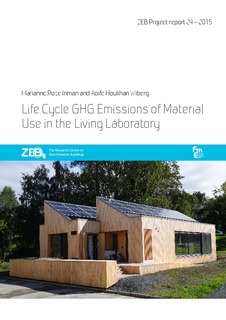| dc.description.abstract | This report documents the design and construction of the ZEB Living Laboratory in Trondheim; with a view to better understand the implication of design choices on embodied material emissions. Accordingly, the material inventory in terms of the building envelope, building services, and energy supply system are presented in-depth. The embodied material emission results are presented for each building component category, and highlight important design drivers for the reduction of embodied material emissions in the construction of buildings. A material emission balance is also presented.
Compared to previous ZEB projects, the results show relatively high emissions, with total emissions of 23.5kgCO2eq/m2/yr, whereby 12.1kgCO2eq/m2/yr originate from the production phase (A1 – A3). There are multiple reasons for this. Firstly, a more comprehensive material inventory was available for the Living Laboratory at an 'as built' stage. The system boundary includes more life cycle stages (A1 – A3, A4, A5 and B4). Furthermore, the building is not a typical residential building but a test laboratory.
The results demonstrate that the choice of insulation material is a key design driver in lowering embodied material emissions, and that even state-of-the-art insulation materials, with typically high embodied emission factors, can be applied in a sensitive and effective way for low total embodied emissions. The results demonstrate that when half the quantity of concrete is used in the strip foundation design, then embodied emissions are significantly reduced. The foundation design may also be further optimised through specifying low carbon concrete. Another design driver is identified in the timber superstructure, which has a relatively low contribution to total embodied emissions, despite its large volume. It is suspected that a corresponding concrete and steel structure will not only weigh more, but also result in a two-fold increase in emissions. The results demonstrate that approximately half of all embodied emissions originate from the outer roof and PV system. This is because of the roof profile and building adapted PV system used, and highlights an area for further optimisation.
The findings show that the reference service lifetime (RSL) of materials can greatly affect the distribution of emissions across life cycle phases, whereby a short RSL has higher embodied emissions in the replacement phase (B4), and a long RSL, in line with the lifetime of the building, has a larger focus on production phase emissions (A1 - A3). The material emission balance also highlights that further measures are required to reduce material emissions and increase on-site renewable energy production, in order to reach a zero emission balance. The sensitivity analysis of the functional unit questions the use of a 60-year building lifetime, when the Living Laboratory is a temporary building. It is therefore recommended that the end-of-life (EOL) life cycle phases are considered in more detail, in order to optimise the demountability and recyclability of the building, instead of the durability of materials. In conclusion, it was found that these results provide useful approximations for embodied material emission calculations, when a detailed material inventory may not be available. It also highlights methodological and design considerations when carrying out a life cycle assessment of a building. Furthermore, the Living Laboratory provides alternative solutions for low embodied emission design. | |
